南通特色 蓝印花布 英文介绍
- 格式:ppt
- 大小:1.91 MB
- 文档页数:26
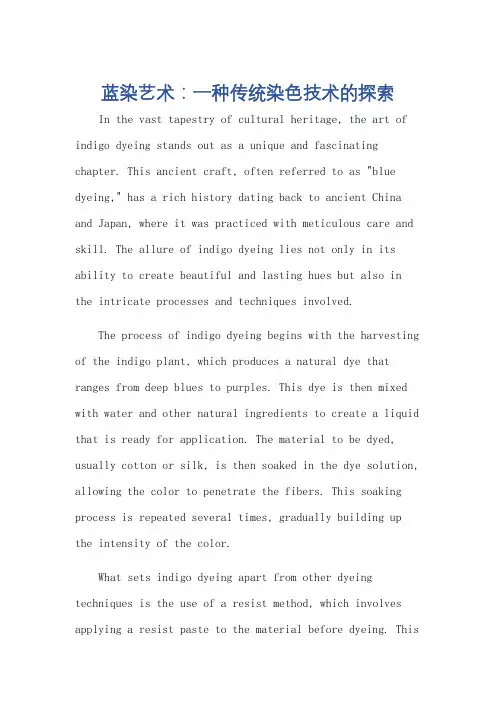
蓝染艺术:一种传统染色技术的探索In the vast tapestry of cultural heritage, the art of indigo dyeing stands out as a unique and fascinating chapter. This ancient craft, often referred to as "blue dyeing," has a rich history dating back to ancient China and Japan, where it was practiced with meticulous care and skill. The allure of indigo dyeing lies not only in its ability to create beautiful and lasting hues but also in the intricate processes and techniques involved.The process of indigo dyeing begins with the harvesting of the indigo plant, which produces a natural dye that ranges from deep blues to purples. This dye is then mixed with water and other natural ingredients to create a liquid that is ready for application. The material to be dyed, usually cotton or silk, is then soaked in the dye solution, allowing the color to penetrate the fibers. This soaking process is repeated several times, gradually building up the intensity of the color.What sets indigo dyeing apart from other dyeing techniques is the use of a resist method, which involves applying a resist paste to the material before dyeing. Thispaste, made from substances like mud, rice paste, or wax, blocks the dye from penetrating certain areas, creating patterns and designs that are both unique and beautiful. The resist paste is removed after dyeing, revealing the underlying blue hue, which contrasts beautifully with the white or natural color of the untreated areas.The art of indigo dyeing is not just about the final product, but also about the journey. Each step of the process requires meticulous attention to detail, from harvesting the indigo plant to applying the resist paste and finally soaking the material in the dye solution. This craftsmanship is a testament to the skill and patience of the artisan, who spends hours perfecting each step to create a piece that is both functional and aesthetically pleasing.The beauty of indigo dyeing lies in its ability to capture the essence of nature and translate it into a form that is both timeless and contemporary. The deep blues and purples of the indigo dye are a nod to the sky and the sea, reminding us of the vastness and mystery of nature. At the same time, the intricate patterns and designs createdthrough the resist method are a testament to the creativity and innovation of the artisan.In today's world, where fast fashion and disposable culture are the norm, the art of indigo dyeing serves as a reminder of the value of sustainability and craftsmanship. It reminds us that beauty does not have to be fleeting or disposable; it can be crafted with care and intention, lasting for generations.In conclusion, the art of indigo dyeing is not just a technique for creating beautiful fabrics; it is a cultural heritage that deserves to be preserved and celebrated. It is a testament to the skill and creativity of artisans who have spent generations perfecting this craft, passing down their knowledge and techniques from one generation to the next. As we move forward in the 21st century, it is important to remember the value of such traditional crafts and the role they play in shaping our cultural identity.**蓝染艺术:探索传统染色技术的奥秘**在丰富多彩的文化遗产中,蓝染艺术以其独特和迷人的魅力占据了重要地位。
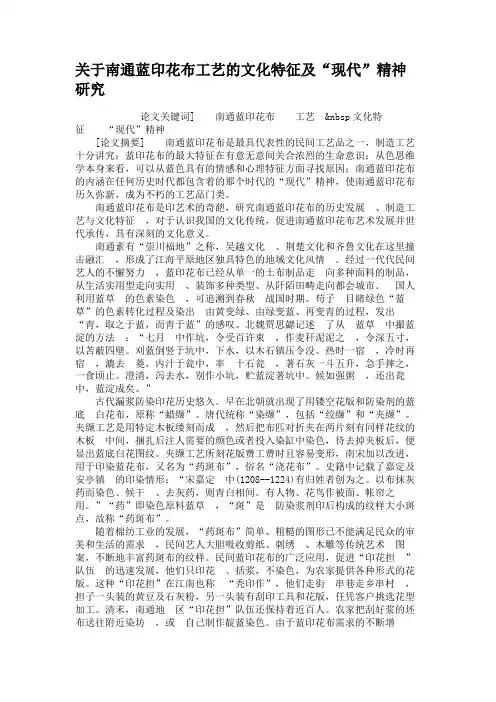
关于南通蓝印花布工艺的文化特征及“现代”精神研究论文关键词] 南通蓝印花布工艺 文化特征“现代”精神[论文摘要] 南通蓝印花布是最具代表性的民间工艺品之一,制造工艺十分讲究;蓝印花布的最大特征在有意无意间关合浓烈的生命意识;从色思维学本身来看,可以从蓝色具有的情感和心理特征方面寻找原因;南通蓝印花布的内涵在任何历史时代都包含着的那个时代的“现代”精神,使南通蓝印花布历久弥新,成为不朽的工艺品门类。
南通蓝印花布是印艺术的奇葩,研究南通蓝印花布的历史发展、制造工艺与文化特征,对于认识我国的文化传统,促进南通蓝印花布艺术发展并世代承传,具有深刻的文化意义。
南通素有“崇川福地”之称,吴越文化、荆楚文化和齐鲁文化在这里撞击融汇,形成了江海平原地区独具特色的地域文化风情。
经过一代代民间艺人的不懈努力,蓝印花布已经从单一的土布制品走向多种面料的制品,从生活实用型走向实用、装饰多种类型、从阡陌田畴走向都会城市。
国人利用蓝草的色素染色,可追溯到春秋战国时期。
苟子目睹绿色“蓝草”的色素转化过程及染出由黄变绿、由绿变蓝、再变青的过程,发出“青,取之于蓝,而青于蓝”的感叹。
北魏贾思勰记述了从蓝草中撮蓝淀的方法:“七月中作坑,令受百许束,作麦秆泥泥之,令深五寸,以苫蔽四壁。
刈蓝倒竖于坑中,下水,以木石镇压令没。
热时一宿,冷时再宿,漉去菱,内汁于瓮中,率十石瓮,著石灰一斗五升,急手摔之,一食顷止。
澄清,泻去水,别作小坑,贮蓝淀著坑中。
候如强粥,还出瓮中,蓝淀成矣。
”古代漏浆防染印花历史悠久。
早在北朝就出现了用镂空花版和防染剂的蓝底白花布,原称“蜡缬”。
唐代统称“染缬”,包括“绞缬”和“夹缬”。
夹缬工艺是用特定木板缕刻而成,然后把布匹对折夹在两片刻有同样花纹的木板中间,捆扎后注人需要的颜色或者投入染缸中染色,待去掉夹板后,便显出蓝底白花图纹。
夹缬工艺所刻花版费工费时且容易变形,南宋加以改进,用于印染蓝花布,又名为“药斑布”,俗名“浇花布”。
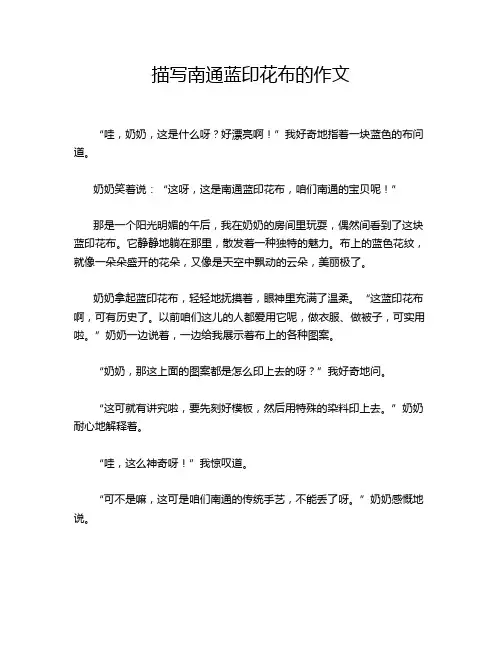
描写南通蓝印花布的作文“哇,奶奶,这是什么呀?好漂亮啊!”我好奇地指着一块蓝色的布问道。
奶奶笑着说:“这呀,这是南通蓝印花布,咱们南通的宝贝呢!”那是一个阳光明媚的午后,我在奶奶的房间里玩耍,偶然间看到了这块蓝印花布。
它静静地躺在那里,散发着一种独特的魅力。
布上的蓝色花纹,就像一朵朵盛开的花朵,又像是天空中飘动的云朵,美丽极了。
奶奶拿起蓝印花布,轻轻地抚摸着,眼神里充满了温柔。
“这蓝印花布啊,可有历史了。
以前咱们这儿的人都爱用它呢,做衣服、做被子,可实用啦。
”奶奶一边说着,一边给我展示着布上的各种图案。
“奶奶,那这上面的图案都是怎么印上去的呀?”我好奇地问。
“这可就有讲究啦,要先刻好模板,然后用特殊的染料印上去。
”奶奶耐心地解释着。
“哇,这么神奇呀!”我惊叹道。
“可不是嘛,这可是咱们南通的传统手艺,不能丢了呀。
”奶奶感慨地说。
我看着蓝印花布,想象着以前的人们穿着蓝印花布做的衣服,那该是多么漂亮的场景啊。
“奶奶,那现在还有人做蓝印花布吗?”我有些担心地问。
“有啊,不过比以前少了。
现在的年轻人啊,都不太喜欢这些老手艺咯。
”奶奶无奈地摇摇头。
“那多可惜呀,这么漂亮的东西。
”我有些难过地说。
“是呀,不过咱们得把它传承下去,不能让这么好的东西消失了。
”奶奶坚定地说。
我用力地点点头,“嗯,我也要学,我也要把南通蓝印花布传承下去。
”奶奶笑了,笑得那么开心。
那一刻,我仿佛看到了南通蓝印花布在未来依然绽放着它的光彩,依然被人们喜爱着。
南通蓝印花布,它不仅仅是一块布,它更是南通的历史和文化的象征。
它就像一颗璀璨的星星,在南通的天空中闪耀着。
难道我们不应该好好地珍惜它、传承它吗?。
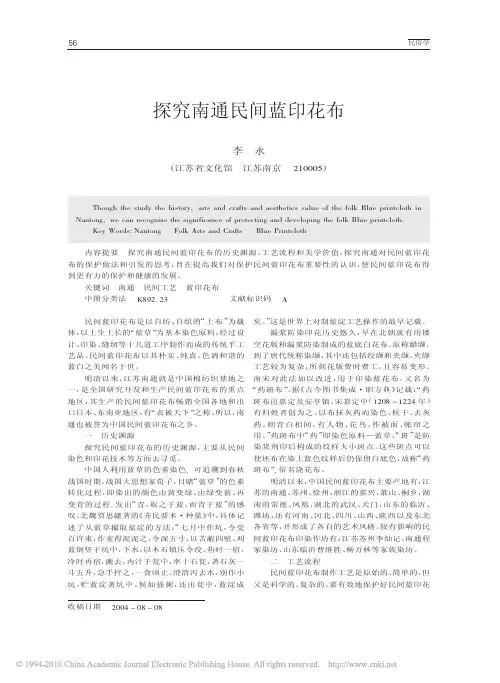
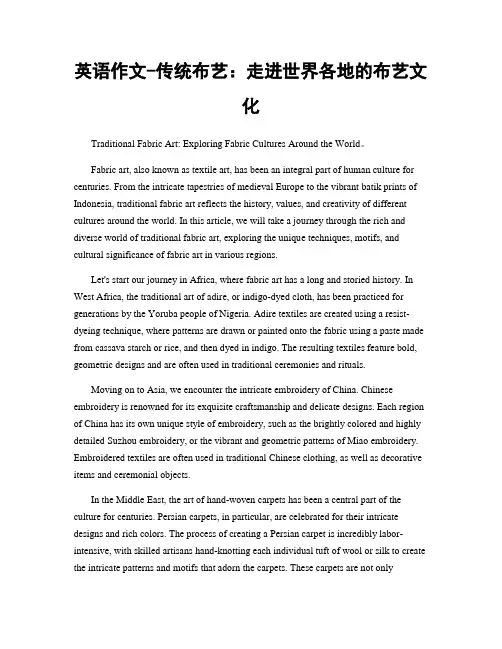
英语作文-传统布艺:走进世界各地的布艺文化Traditional Fabric Art: Exploring Fabric Cultures Around the World。
Fabric art, also known as textile art, has been an integral part of human culture for centuries. From the intricate tapestries of medieval Europe to the vibrant batik prints of Indonesia, traditional fabric art reflects the history, values, and creativity of different cultures around the world. In this article, we will take a journey through the rich and diverse world of traditional fabric art, exploring the unique techniques, motifs, and cultural significance of fabric art in various regions.Let's start our journey in Africa, where fabric art has a long and storied history. In West Africa, the traditional art of adire, or indigo-dyed cloth, has been practiced for generations by the Yoruba people of Nigeria. Adire textiles are created using a resist-dyeing technique, where patterns are drawn or painted onto the fabric using a paste made from cassava starch or rice, and then dyed in indigo. The resulting textiles feature bold, geometric designs and are often used in traditional ceremonies and rituals.Moving on to Asia, we encounter the intricate embroidery of China. Chinese embroidery is renowned for its exquisite craftsmanship and delicate designs. Each region of China has its own unique style of embroidery, such as the brightly colored and highly detailed Suzhou embroidery, or the vibrant and geometric patterns of Miao embroidery. Embroidered textiles are often used in traditional Chinese clothing, as well as decorative items and ceremonial objects.In the Middle East, the art of hand-woven carpets has been a central part of the culture for centuries. Persian carpets, in particular, are celebrated for their intricate designs and rich colors. The process of creating a Persian carpet is incredibly labor-intensive, with skilled artisans hand-knotting each individual tuft of wool or silk to create the intricate patterns and motifs that adorn the carpets. These carpets are not onlybeautiful works of art, but also hold deep cultural and symbolic significance in the Middle Eastern region.Moving to Europe, we find a rich tradition of tapestry weaving. The Bayeux Tapestry, a famous example of medieval European textile art, depicts the events leading up to the Norman conquest of England in 1066. This monumental work of embroidery is over 70 meters long and features detailed scenes of battle, courtly life, and everyday activities. Tapestry weaving was a highly valued art form in medieval Europe, and many of these historical tapestries have been preserved and are on display in museums around the world.Finally, we come to the vibrant and colorful batik prints of Indonesia. Batik is a traditional Indonesian textile art that involves using wax and dye to create intricate patterns on fabric. The process of batik-making is highly skilled and time-consuming, with artisans using a combination of wax-resist dyeing and hand-painting to create the elaborate designs that adorn batik textiles. These textiles are used in traditional Indonesian clothing, as well as decorative items and ceremonial objects.In conclusion, traditional fabric art is a rich and diverse form of cultural expression that reflects the history, values, and creativity of different societies around the world. From the intricate adire textiles of West Africa to the vibrant batik prints of Indonesia, each region has its own unique techniques, motifs, and cultural significance when it comes to fabric art. By exploring the traditional fabric art of different cultures, we gain a deeper understanding and appreciation of the beauty and diversity of the world's textile traditions.。
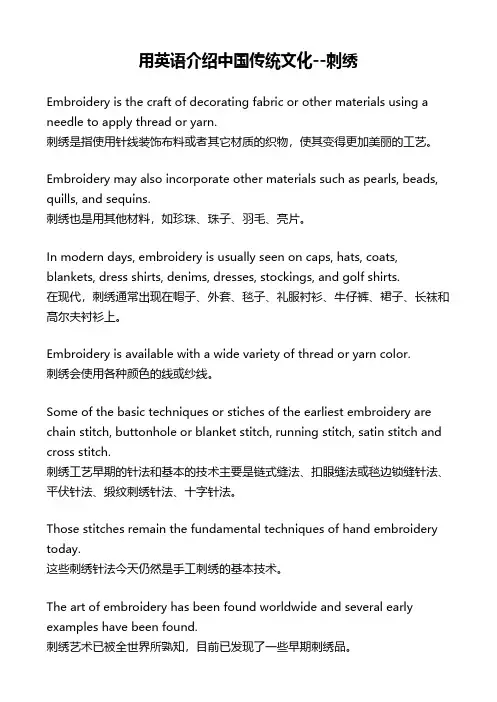
用英语介绍中国传统文化--刺绣Embroidery is the craft of decorating fabric or other materials using a needle to apply thread or yarn.刺绣是指使用针线装饰布料或者其它材质的织物,使其变得更加美丽的工艺。
Embroidery may also incorporate other materials such as pearls, beads, quills, and sequins.刺绣也是用其他材料,如珍珠、珠子、羽毛、亮片。
In modern days, embroidery is usually seen on caps, hats, coats, blankets, dress shirts, denims, dresses, stockings, and golf shirts.在现代,刺绣通常出现在帽子、外套、毯子、礼服衬衫、牛仔裤、裙子、长袜和高尔夫衬衫上。
Embroidery is available with a wide variety of thread or yarn color.刺绣会使用各种颜色的线或纱线。
Some of the basic techniques or stiches of the earliest embroidery are chain stitch, buttonhole or blanket stitch, running stitch, satin stitch and cross stitch.刺绣工艺早期的针法和基本的技术主要是链式缝法、扣眼缝法或毯边锁缝针法、平伏针法、缎纹刺绣针法、十字针法。
Those stitches remain the fundamental techniques of hand embroidery today.这些刺绣针法今天仍然是手工刺绣的基本技术。
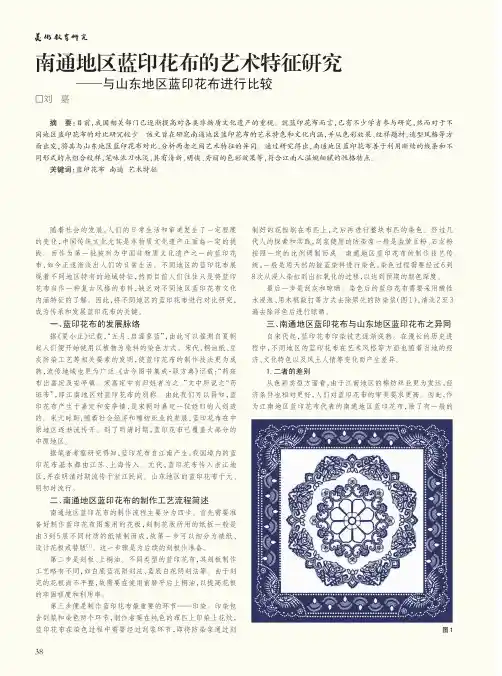
南通地区蓝印花布的艺术特征研究——与山东地区蓝印花布进行比较□刘嘉摘要:目前,我国相关部门已逐渐提高对各类非物质文化遗产的重视。
就蓝印花布而言,已有不少学者参与研究,然而对于不同地区蓝印花布的对比研究较少。
该文旨在研究南通地区蓝印花布的艺术特色和文化內涵,并从色彩效果、纹样题材、造型风格等方面出发,将其与山东地区蓝印花布对比,分析两者之间艺术特征的异同。
通过研究得出,南通地区蓝印花布善于利用断续的线条和不同形式的点组合纹样,笔味浓刀味淡,具有清新、明快、秀丽的色彩效果等,符合江南人温婉细腻的性格特点。
关键词:蓝印花布南通艺术特征随着社会的发展,人们的日常生活和审美发生了一定程度的变化,中国传统文化尤其是非物质文化遗产正面临一定的挑战。
而作为第一批被列为中国非物质文化遗产之一的蓝印花布,如今正逐渐淡出人们的日常生活。
不同地区的蓝印花布展现着不同地区特有的地域特征,然而目前人们往往只是将蓝印花布当作一种复古风格的布料,缺乏对不同地区蓝印花布文化内涵特征的了解。
因此,将不同地区的蓝印花布进行对比研究,成为传承和发展蓝印花布的关键。
一、蓝印花布的发展脉络据《夏小正》记载,“五月,启灌蓼蓝”,由此可以推测自夏朝起人们便开始使用以植物为染料的染色方式。
宋代,桐油纸、豆灰防染工艺等相关要素的发明,使蓝印花布的制作技法更为成熟,流传地域也更为广泛。
《古今图书集成•职方典》记载:“药斑布出嘉定及安亭镇。
宋嘉定中有归姓者为之。
”文中所说之“药斑布”,即江南地区对蓝印花布的别称。
由此我们可以得知,蓝印花布产生于嘉定和安亭镇,是宋朝时嘉定一位姓归的人创造的。
宋元时期,随着社会经济和棉纺织业的发展,蓝印花布在中原地区逐渐流传开。
到了明清时期,蓝印花布已覆盖大部分的中原地区。
据笔者考察研究得知,蓝印花布自江南产生,我国境内的蓝印花布基本都由江苏、上海传入。
元代,蓝印花布传入浙江地区,并在明清时期流传于浙江民间。
山东地区的蓝印花布于元、明初时流行。
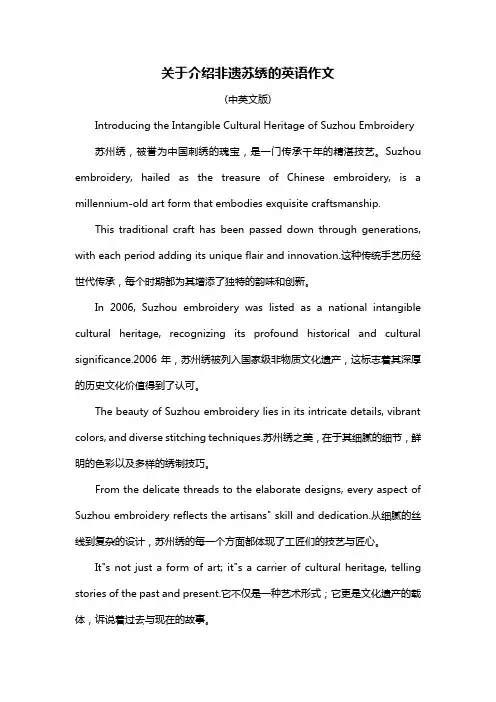
关于介绍非遗苏绣的英语作文(中英文版)Introducing the Intangible Cultural Heritage of Suzhou Embroidery 苏州绣,被誉为中国刺绣的瑰宝,是一门传承千年的精湛技艺。
Suzhou embroidery, hailed as the treasure of Chinese embroidery, is a millennium-old art form that embodies exquisite craftsmanship.This traditional craft has been passed down through generations, with each period adding its unique flair and innovation.这种传统手艺历经世代传承,每个时期都为其增添了独特的韵味和创新。
In 2006, Suzhou embroidery was listed as a national intangible cultural heritage, recognizing its profound historical and cultural significance.2006年,苏州绣被列入国家级非物质文化遗产,这标志着其深厚的历史文化价值得到了认可。
The beauty of Suzhou embroidery lies in its intricate details, vibrant colors, and diverse stitching techniques.苏州绣之美,在于其细腻的细节,鲜明的色彩以及多样的绣制技巧。
From the delicate threads to the elaborate designs, every aspect of Suzhou embroidery reflects the artisans" skill and dedication.从细腻的丝线到复杂的设计,苏州绣的每一个方面都体现了工匠们的技艺与匠心。
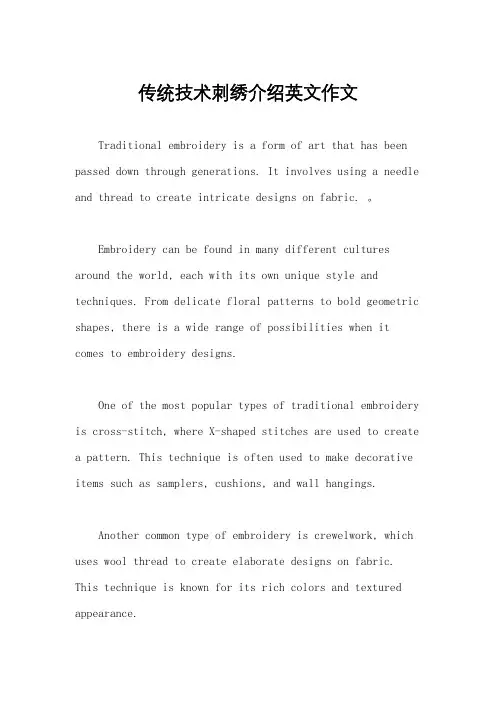
传统技术刺绣介绍英文作文Traditional embroidery is a form of art that has been passed down through generations. It involves using a needle and thread to create intricate designs on fabric. 。
Embroidery can be found in many different cultures around the world, each with its own unique style and techniques. From delicate floral patterns to bold geometric shapes, there is a wide range of possibilities when it comes to embroidery designs.One of the most popular types of traditional embroidery is cross-stitch, where X-shaped stitches are used to create a pattern. This technique is often used to make decorative items such as samplers, cushions, and wall hangings.Another common type of embroidery is crewelwork, which uses wool thread to create elaborate designs on fabric. This technique is known for its rich colors and textured appearance.Embroidery can be a time-consuming and meticulous process, requiring patience and attention to detail. However, the end result is always worth the effort, as embroidered pieces are often treasured for their beauty and craftsmanship.In today's modern world, traditional embroidery techniques are still being used and appreciated by artists and crafters. Whether it's creating a vintage-inspired piece or adding a personal touch to a garment, embroidery continues to be a popular form of creative expression.。

南通蓝印花布:在岁月中雕染蓝印花布,是一种在白布上用靛蓝染出蓝白相间图案的中国民间传统手工艺品,已有一千多年历史。
蓝底白花,或白底蓝花,以斑点的粗细、疏朗组合成各种纹样图案,日常的衣服、床褥、包袱布、桌布等都可以用到蓝印花布。
它在江苏、浙江、湖南、山东等地区都有分布,江苏南通地区的蓝印花布曾有着最广泛的生产和使用,南通被誉为中国蓝印花布之乡,在工艺和纹样上都有其鲜明特色,2006年入选国家非物质文化遗产保护名录。
南通,古名为胡逗洲,因为远古时代,南通是一片茫茫的江口海域,随着长江泥沙的沉积,形成了沙洲、浅滩,逐步发展成陆地。
汉代,当地人开始“煮海为盐”,成为历史上著名的产盐区。
盐业厚利,促进了城市繁荣发展,城市规模也日益扩大,至明代已成为苏北重要的城市。
后随着海岸线东移,盐业开始衰落,取而代之的是植棉业的发展和家庭手工土布业的兴盛。
南通属于亚热带季风气候,四季分明,气候温和,光照充足,雨水充沛,无霜期长,年平均气温约16℃左右,加上地势平坦,土质细而松,排水良好,非常适宜种植棉花。
早在元末明初,南通已从隔江相望的苏南地区引进了棉种和植棉技术,发展到清代,南通已成为重要的棉花产区之一。
1895年,清末状元张謇回家乡兴办纺织厂和企业,土布被广泛生产和应用,南通成为中国近代纺织工业的发祥地之一,成为闻名遐迩的纺织城。
蓝印花布是从宋朝的“药斑布”发展而来,《嘉定县志》记载:“以灰药涂布染青,俟干拭去,青白成文,有山水、楼台、人物、花果、鸟兽诸像”,药是指染料原料蓝靛,斑是指蓝色的纹样,到了清代又称之为“浇花布”。
除了土布在南通的广泛生产和应用,染色的关键还在于染料原料——蓝草。
蓝草有马蓝、蓼蓝、菘蓝、茶蓝等种类,南通当地多为蓼蓝草。
南通地区温暖湿润的气候,给蓝草提供了适宜的生长环境,蓝草种植在当地农村十分普遍,成为众多农民的副业。
南通人祖祖辈辈多以种蓝草、蔬菜为生,每年农历二月种植蓼蓝草,五月收割头蓝,大暑季节收割二蓝,蓝印花布就是利用蓝草色素染色。

描写南通蓝印花布的作文说起南通蓝印花布,那可真是咱南通的一张独特名片!记得有一年夏天,我跟着家人一起去南通的一个老街游玩。
那天阳光正好,微风不燥,老街的石板路上弥漫着岁月的痕迹。
就在我东张西望,对一切都充满好奇的时候,一家小店门口挂着的蓝印花布瞬间吸引了我的目光。
那一块块蓝印花布,在微风中轻轻摇曳,就像蓝色的海浪在缓缓翻滚。
我忍不住走进店里,想要更近距离地欣赏这美丽的艺术品。
一进店,满眼都是蓝白相间的世界,仿佛置身于一个宁静而神秘的海洋之中。
店里的墙上挂满了各种各样的蓝印花布制品,有桌布、窗帘、衣服,还有小巧玲珑的手帕和香囊。
我走到一块桌布前,仔细地端详起来。
那蓝色,不是那种纯粹的湛蓝,而是带着一点靛青的色调,深沉而又古朴。
白色的花纹则像是在蓝色的海洋中跳跃的浪花,灵动而又活泼。
我轻轻用手抚摸着桌布,布料的质感有些粗糙,但却给人一种温暖而踏实的感觉。
那些花纹,有的是简单的几何图案,有的则是栩栩如生的花鸟鱼虫。
我发现每一个图案都不是简单的重复,而是有着细微的差别,仿佛每一块布都有着自己的故事。
再看那白色的花纹,边缘并不是整齐划一的,而是带着一些手工制作的痕迹,有点毛毛糙糙的,但这恰恰增添了它的韵味。
凑近了闻一闻,还有一股淡淡的草木香气,那是染料和布料融合在一起的味道,让人感到无比的清新和舒适。
我好奇地问店主,这些蓝印花布是怎么制作出来的。
店主是一位和蔼可亲的阿姨,她笑着给我介绍起来。
她说,制作蓝印花布可不是一件简单的事情,从刻板、刮浆到染色、晾晒,每一道工序都需要精心操作。
先说刻板吧,师傅们要用特制的刀具在木板上刻出图案。
这可真是个技术活,一刀一刀都要刻得精准无误,稍有差错,整个图案就会走样。
而且,那些图案都是师傅们凭借着自己的经验和想象力创作出来的,每一个都独一无二。
刻好板之后,就要进行刮浆了。
把黄豆粉和石灰粉混合成的浆糊,均匀地刮在白布上,然后把刻好的木板压在上面,让图案印在布上。
这一步需要非常细心,浆糊的厚度和均匀度都会影响到最后的效果。
书山有路勤为径;学海无涯苦作舟
中国传统蓝印花布工艺介绍
中国传统蓝印花布工艺介绍
中国人利用棉纤维织布的历史可以追溯到公元之初,到了十三世纪末手
工棉纺织技术已在苏皖、江浙等地区广泛传播,蓝印花布工艺也随之得到普遍应用。
旧时,浙江、江苏一带农村家家户户都会织布、染布。
老辈人身上穿
的衣服、日常用的包袱皮,甚至自家闺女的嫁妆,都是自家纺织印染的蓝印花布。
窗帘、头巾、围裙、包袱、帐子等都可用它来做。
蓝印花布仿佛就是劳动人民的专用布料。
它的图案充满浓郁的乡土气息,自然,清新。
江浙一带蓝印花布的主要产地就在江苏的南通地区。
在南通地区,自古以来民风淳朴,在明清时期,由于南通当时的气候
地理环境非常特殊,温暖湿润,特别适宜棉花和“蓝草”的生长,并且
“蓝草”和棉花种植在当地农村十分普遍,再加上当地的民间纺织技术又
十分发达,家家都有木制的纺车和织机,家家可闻布机声,户户都有织布娘。
故在明清时期,南通的染织蓝印花布的作坊已发展成有规模的街市,据明代《南通县志》记载,在“染织局”登记在册的手工染坊就有十九家
之多。
专注下一代成长,为了孩子。
非物质文化遗产南通蓝印花布印染技艺工艺作者:金鑫来源:《纺织报告》 2014年第10期金鑫蓝印花布是我国传统工艺美术的重要组成部分,它源于秦汉,始于宋代,盛于明清。
蓝印花布自宋代以来,因其工艺相对简洁,质地牢固耐用,纹样寓意丰富而深受百姓的喜爱,曾作为被面、包袱布、帐檐等广泛应用于百姓的日常生活中。
江苏、浙江、山东、河北等地都曾是蓝印花布的主产区,因地理位置、民俗风情的差异,蓝印花布的图案也烙上了各地的特点。
南通蓝印花布分为蓝底白花和白底蓝花,纹样的特点是点、线、面并用,形成丰富多样的独特的艺术效果。
南通蓝印花布印染工艺从挑选优质的坯布开始,农家一般都挑选棉质好的上等布料,要求用布面平、色质白、质地紧的白布来染制蓝印花布,普通坯布用以染制纯蓝色或制作其他生活用品。
南通蓝印花布印染技艺仍保留着最传统的工艺制作流程:刻花版用自裱的纸版或牛皮纸浸泡桐油晾干后裁成所需要版面的大小,将设计草图裱在花版上或从老花版替下花纹,刻版时以刀代笔。
花版刻完后刷桐油数次后晾干、压平、磨光后即可使用。
刮浆防染浆用黄豆粉、石灰粉加水调制而成。
调浆时厚薄(粘稠)要适中,刮浆用力要均匀,花型复杂时对版要准确,排版要自如。
然后将刮有防染浆的坯布晾干。
染色把刮上浆的布松开放在清水中浸泡,直至布浸湿到浆料发软后即可下缸染色。
布下缸20分钟后取出氧化、透风30 分钟,并不断转动布面使其靛蓝氧化还原均匀,根据面料的不同和气候变化可调整下缸和氧化的时间,一般经过6 至8 次反复染色,使其达到所需颜色。
刮灰把灰浆布绷在支架上,用家用菜刀或定制两头圆形的刮灰刀倾斜45°用力适中刮去灰浆,再进行二次“吃”酸固色,后清洗2 至3 次使之蓝白分明。
清洗、晾晒布经刮灰后需要清洗2-3 次,以去除残留在布面上的灰浆及浮色,再用长竹竿将湿布挑至7m 高的晒布架上。
因受到刮浆、染色、晾晒等工艺因素的影响,蓝印花布每匹布料的长防染浆用黄豆粉、石灰粉加水调度一般限定在12m以内。
[键入文字]
蓝印花布介绍独树一帜的艺术
蓝印花布曾经是中国江南一带很流行的传统布料,它是以农村自家纺棉手织的棉布为面料印制而成。
蓝印花布是江苏的符号之一,南通蓝印花布具有浓厚的乡土气息,它的实用性和观赏性使其延续至今仍然受大众的喜爱。
无论工艺还是纹样都有其鲜明的艺术特色,是中国蓝印花布的典型代表。
尽管科技的步伐已经越走越快,但仍有不少人十分钟情于旧时的衣裳花样和纹路。
南通蓝印花布通过一代又一代的传承保留下来的文化遗产,蓝印花布在以前用途较广,可做被褥面、服装、蚊账、包袱、门帘等。
今天小编为大家奉上一组关于蓝印花布介绍的相关知识,希望对大家了解蓝印花布有所帮助。
一起来看看吧!
蓝印花布简介
蓝印花布又称靛蓝花布,俗称药斑布、浇花布等。
是汉族传统的工艺印染品,镂空版白浆防染印花,距今已有一千三百年历史。
最初以蓝草为染料印染而成。
蓝印花布用石灰、豆粉合成灰浆烤蓝,采用全棉、全手工纺织、刻版、刮浆等多道印染工艺制成。
在中国汉族民间艺术中堪称独树一帜。
蓝印花布制作工艺
首先,从蓼蓝草中提取蓝作染料(靛蓝),把镂空花版铺在白布上,用刮浆板把防染浆剂刮入花纹空隙漏印在布面上,干后放入染缸,布下缸20分钟后取出氧化、透风30
1。